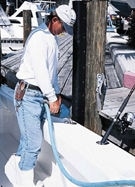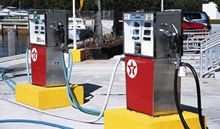
| Knowing what to look for in gasoline will help save you money and keep your engine running properly at the same time. |
The world of outboard motors has changed quickly, and suddenly there are three different kinds of engines on the waterfront: four-strokes, fuel-injected two-stokes, and carbureted two-strokes. And along with them comes a crop of questions, rumors and suspicions about the best gas to use in each and the best way to assure durability and performance. Recently, we tossed around a couple of questions about gasoline raised by a loyal reader we’ll call Diligent Boater.
Dil has a 225-hp two-cycle outboard that is supposed to run on 87-octane gasoline. His marina only sells 93 octane, and he wondered why the marina sells premium gas when so many motors require 87 octane. Additionally, he was under the impression that the premium gasoline would only partially burn in his motor. Wouldn’t the excess, unburned fuel be sent out the exhaust and end up in the water?
Which Octane?
To answer the last question first: no. Premium gasoline does not pass partially burned through an engine designed to run on lower octane fuels. It burns as completely as a mid-range-octane or low-octane gasoline. In fact, 93 octane will perform just as well as lower octane; it just isn’t necessary to spend the money on it. The only thing that gets damaged when you run 93 octane in a motor rated for lower octane is your wallet. It’s like putting synthetic oil in your car, then continuing to change it every 2,000 miles. It’s wasted money.
Now for Dil’s marina. Not all marinas sell only 93-octane gas. They’ll pretty much sell what their customers demand. Due to limited space, many marinas will carry only one or two grades of fuel. A survey of marinas in South Florida found that the ones catering mostly to recreational boaters and fishermen sold 89 octane. Marinas with a big thunderboat and go-fast clientele carried only 93, and some crossovers carried both. Maybe Dil really likes his marina, and the convenience is worth the extra bucks he’s dropping on the premium fuel that he doesn’t need. But maybe he should find another place to buy gas.
Then the question remains: why are these marinas selling 89 octane (except for Dil’s, which sells premium), instead of the 87 that is recommended for most engines?
According to David Greenwood, Quality Research Testing Supervisor for Suzuki, it’s a perception thing that makes the buyer feel better, and it’s rooted in the more-octane-equals-better-gas-equals-more-power myth.
“The guy who buys a mid-range octane feels he’s getting a better product for his motor without paying the premium price,” Green-wood says. “Higher octane doesn’t mean more power, although a lot of people think it does. People feel better when they buy a better-than-minimum-octane gasoline.”
On the way to answering Dil’s questions, we encountered some new ones. So, we decided to check out a few, such as the one concerning the fuel requirements of two-stroke versus four-stroke motors: Are they different?
Again, for the majority of motors the answer is “no.” However, some of the monster motors at the top end of the power scale will run better on high-octane, premium gasoline. These engines come with recommendations to use higher octane to prevent knocking. Otherwise, all the manufacturers we talked to said their motors were designed to run on gasoline with 87 octane.
Octane vs. Detergency
If 87 octane is the minimum, then aren’t you doing your motor a favor (and milking a little more power out of it) by buying premium gas? Not really, according to Steve Bethel, Director of Advanced Product Engineering for Mercury Marine.
“People often have the perception that a high-octane or mid-range-octane gasoline gives them additional benefits, such as increased detergency. This is not true,” says Bethel. “All fuels have a certain amount of detergency. With higher-octane fuel, you just get higher octane, not a better quality of fuel.”
The principal differences between the different octane levels in gasoline has nothing to do with quality or additives. In fact, it has nothing to do with anything except the temperature at which the fuel ignites. Premium gas has a more predictable flash point, to control the burn in the higher compression ratios of high-performance engines. Putting lower-octane gas in a high-performance motor rated for premium gasoline may cause that motor to knock. Obviously, you don’t want that. But putting high-octane gas in a regular outboard won’t do a thing except lighten your wallet. It will not give you any more power.
Playing It Safe
However, there is a time when it makes sense to upgrade to a premium gasoline, and that’s when you are unsure of the quality of the gas you are buying. Aftermarket or “off-brand” gasoline stations may have gas that is just as good as brand-name gas, but you never know for sure. For example, it’s not unusual for some aftermarket retailers to cut their gasoline with alcohol, according to Suzuki’s Greenwood.
“Sometimes distributors add ethanol to the gas, then the retailer might do the same. There can be a substantial difference between what you think you are buying and what actually ends up going through the cylinders.
“We have found, at times, up to 20-percent ethanol in gasoline coming out of the pump,” says Greenwood. “If you are buying gasoline that is of poor or suspicious quality, you are better off buying the premium grade.
“Even the premium may have been diluted. A diluted 93-octane gas is going to be closer to what you want than a diluted 87-octane. If the gas has been diluted, buying higher octane will get you closer to the mid-range octane grade you’re looking for.”
Additives Are Important
Octane questions aside, one thing everybody agrees on is the importance of buying quality fuel. “The best thing you can do for any motor is buy gas of known, high quality,” says David Grigsby, Yamaha’s product manager. “We recommend 87 octane for both our two- and four-stroke motors. We stress the importance of a good, name-brand gasoline.”
Additionally, Grigsby says Yamaha recommends the regular use of fuel additives, such as conditioner, stabilizer, combustion-chamber cleaner and gas-line anti-freeze. Most motor manufacturers market their own brands of these additives. Each is slightly different, perhaps, but they’re all made by a limited number of additive manufacturers, and there is no real “secret technology” involved. Suffice it to say that you can’t go wrong with any of them when used properly.
Fuel conditioner basically contains a detergent boost, to remove deposits that accumulate inside the engine. With two-cycle motors, this is mostly ring-groove deposits. With four-strokes, the fuel intakes and combustion chamber benefit most. You can run a fuel conditioner regularly or occasionally, depending on the duty cycle of your motor – how often you run it and how hard. What really determines how often you should use a conditioner is the quality of the gas and the oil you use.
Since this is a high-detergent additive, it can clean up the deposits that accumulate from using low-grade gasoline. Oil quality also makes a difference, especially in two-cycle engines. Oil sold under the outboard manufacturer’s label – though higher in cost than generics – generally has enough additives and detergents to make fuel additives less critical. Use a low-cost generic oil and you’ll likely benefit more from fuel conditioner.
Fuel stabilizer protects the motor from sour gas – the oxidation that takes place when fuel sits in the engine for extended periods. If you store your boat for the winter, you need to run stabilizer through the fuel system when you lay it up. Even if you hang it off the davits for just a month in the Florida Keys, you should put stabilizer in the tank.
Gas line anti-freeze has the same dual purpose. This additive takes care of water in the fuel, water that collects due to condensation more than anything else. In the north it turns to ice, which is bad news inside your engine. In the near-tropical conditions of the south, moisture accumulates on the inside of the gas tank due to high heat and high humidity. It needs to be either filtered out or bound chemically to the gasoline so it can pass through the engine, which is what this additive does.
Anti-freeze, however, needs to be used carefully. Suzuki’s Greenwood explains: “Fuel anti-freeze will eliminate moisture from the gas, but too much of it can also wash the oil off the cylinder walls, especially on a two-stroke. Occasional use won’t hurt, but don’t use it regularly. If you are getting moisture in your tank, drain it. Plastic tanks reduce a lot of condensation problems. They don’t cause as much moisture accumulation as metal tanks. The best protection is a good water-separating filter and quality gas.”
So there are no big secrets here. Although outboard engines seem loaded with baffling new technology, the fact remains that gassing up your boat is actually pretty simple. Follow the manufacturer’s recommendations and use common sense.
The one persistent myth regarding gas we weren’t able to dispel is the one that says the best thing you can do for your motor is to use it as often as you can. That appears to be true!

What Does Octane Do?The octane rating is a reference number that indicates the ability of fuel to resist detonation. Most outboards are designed for maximum efficiency with 87-octane gasoline. High-performance outboards extract more power from gasoline by creating higher pressure in the cylinders at the time of fuel burn. If you run too low an octane gas in a high-performance engine, that higher cylinder pressure causes the fuel to explode too soon, before the piston is positioned properly. This premature detonation is called “knock.” Increasing the octane – which is done at the time of manufacture with additives – keeps the fuel from exploding too soon. Severe knock not only robs the engine of power and efficiency, it can damage components. – Glenn Law|









